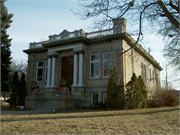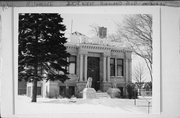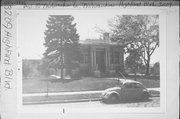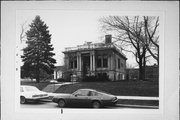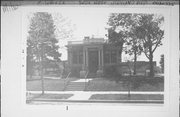| Additional Information: | A 'site file' exists for this property. It contains additional information such as correspondence, newspaper clippings, or historical information. It is a public record and may be viewed in person at the Wisconsin Historical Society, State Historic Preservation Office.
This two-story cream brick Neoclassical Revival house of 1897 was designed by Edward V. Koch of Milwaukee for George Koch, the vice-president of the West Side Bank. Previously at 1018 National. The house features lion statues in front of a Corinthian protico. Winter was the builder. Gutted by fire in the 1980s, the building has since been turned into office space. Other map codes include 19/15 LUQS #388 and Z/246.
"Banker George Koch's Beaux Arts style residence has often been mistaken for a library building. Architect Edward V. Koch based his design on the Neoclassical style country villas of early 19th century Europe. He cleverly gave the small structure a monumental appearance by using grand, over-scaled features including classical balustrades, columns, and a very impressive front entrance. The stone lions at the front steps have led to the building's nicknames, the Lion House, and have also contributed to the misconception that it is a public building rather than a house. The unusual one-story-on-a-raised-basement form of the house is reminiscent of Milwaukee's other Lion House onthe city's East Side at 1241 N. Franklin Place built for Edward Diederichs 40 years earlier. It is interesting that this unusual one-story-with-raised-basment vulla type was always built in Milwaukee by those of German ethnicity. At one time there were other houses of this kind, but today the Koch and Diederichs house are the best surviving examples. In this particular instance, both the owner and the architect may have been influenced by the much admired Diederichs House, although there is no way to know for sure whether that was the case of whether they were directly inspired by European houses.
George Koch was born in Milwaukee in 1863, the son of miller John Koch, who later operated a flour and feed store at 2044 N. 3rd Street. George Koch began work for the Frankfurth Hardware Co., and then was employed at the Manufacturers Bank. He later worked for the Merchants and Exchange Bank and served as its cashier and then vice-president when the institution reorganized as the West Side Bank.
George Koch married Amelia Millenbach of Detroit in 1896 when he was 33, and a year later has his brother, Edward V. Koch, design this one-of-a-kind residence for them. Koch died at age 57 in 1922, and his widow apparently left Milwaukee soon afterward. The house on Highland Boulevard was subsequently rented. Years later, as Concordia College (now the Indian Community School) expanded north from State Street, the college acquired this building. It kept the Koch House for use as an administration building, perhaps because it looked so much like a public building anyway, but razed its neighbors for a campus expansion that never happened. The abandoned house was vandalized and later suffered a devastating fire in the 1980s that gutted its interior. It has since been restored on the exterior to its original appearance and rehabilitated on the interior for office use." MILWAUKEE ETHNIC HOUSES TOUR, CITY OF MILWAUKEE DEPARTMENT OF CITY DEVELOPMENT, 1994. |
|---|

